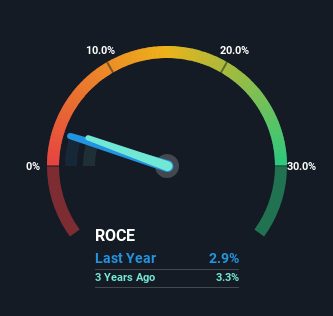The Returns On Capital At YHI International (SGX:BPF) Don't Inspire Confidence
When it comes to investing, there are some useful financial metrics that can warn us when a business is potentially in trouble. Typically, we'll see the trend of both return on capital employed (ROCE) declining and this usually coincides with a decreasing amount of capital employed. Trends like this ultimately mean the business is reducing its investments and also earning less on what it has invested. On that note, looking into YHI International (SGX:BPF), we weren't too upbeat about how things were going.
Return On Capital Employed (ROCE): What Is It?
For those that aren't sure what ROCE is, it measures the amount of pre-tax profits a company can generate from the capital employed in its business. To calculate this metric for YHI International, this is the formula:
Return on Capital Employed = Earnings Before Interest and Tax (EBIT) ÷ (Total Assets - Current Liabilities)
0.029 = S$8.8m ÷ (S$379m - S$72m) (Based on the trailing twelve months to June 2023).
So, YHI International has an ROCE of 2.9%. In absolute terms, that's a low return and it also under-performs the Retail Distributors industry average of 4.6%.
See our latest analysis for YHI International
Historical performance is a great place to start when researching a stock so above you can see the gauge for YHI International's ROCE against it's prior returns. If you'd like to look at how YHI International has performed in the past in other metrics, you can view this free graph of past earnings, revenue and cash flow.
What Can We Tell From YHI International's ROCE Trend?
In terms of YHI International's historical ROCE movements, the trend doesn't inspire confidence. To be more specific, the ROCE was 4.8% five years ago, but since then it has dropped noticeably. Meanwhile, capital employed in the business has stayed roughly the flat over the period. This combination can be indicative of a mature business that still has areas to deploy capital, but the returns received aren't as high due potentially to new competition or smaller margins. So because these trends aren't typically conducive to creating a multi-bagger, we wouldn't hold our breath on YHI International becoming one if things continue as they have.
On a side note, YHI International has done well to pay down its current liabilities to 19% of total assets. So we could link some of this to the decrease in ROCE. What's more, this can reduce some aspects of risk to the business because now the company's suppliers or short-term creditors are funding less of its operations. Since the business is basically funding more of its operations with it's own money, you could argue this has made the business less efficient at generating ROCE.
The Key Takeaway
In summary, it's unfortunate that YHI International is generating lower returns from the same amount of capital. Yet despite these concerning fundamentals, the stock has performed strongly with a 57% return over the last five years, so investors appear very optimistic. In any case, the current underlying trends don't bode well for long term performance so unless they reverse, we'd start looking elsewhere.
On a final note, we've found 2 warning signs for YHI International that we think you should be aware of.
While YHI International isn't earning the highest return, check out this free list of companies that are earning high returns on equity with solid balance sheets.
Have feedback on this article? Concerned about the content? Get in touch with us directly. Alternatively, email editorial-team (at) simplywallst.com.
This article by Simply Wall St is general in nature. We provide commentary based on historical data and analyst forecasts only using an unbiased methodology and our articles are not intended to be financial advice. It does not constitute a recommendation to buy or sell any stock, and does not take account of your objectives, or your financial situation. We aim to bring you long-term focused analysis driven by fundamental data. Note that our analysis may not factor in the latest price-sensitive company announcements or qualitative material. Simply Wall St has no position in any stocks mentioned.

